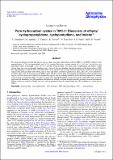Por favor, use este identificador para citar o enlazar a este item:
http://hdl.handle.net/10261/258189COMPARTIR / EXPORTAR:
 SHARE SHARE
 CORE
BASE CORE
BASE
|
|
| Visualizar otros formatos: MARC | Dublin Core | RDF | ORE | MODS | METS | DIDL | DATACITE | |

| Título: | Pure hydrocarbon cycles in TMC-1: Discovery of ethynyl cyclopropenylidene, cyclopentadiene, and indene |
Autor: | Cernicharo, José CSIC ORCID ; Agúndez, Marcelino CSIC ORCID; Cabezas, Carlos CSIC ORCID; Tercero, Belén CSIC ORCID; Marcelino, Nuria CSIC ORCID; Pardo Carrión, Juan Ramón CSIC ORCID ; Vicente, P. de | Palabras clave: | Molecular data Line: identification ISM: molecules ISM: individual objects: TMC-1 Astrochemistry |
Fecha de publicación: | 13-may-2021 | Editor: | EDP Sciences | Citación: | Astronomy and Astrophysics 649: L15 (2021) | Resumen: | We report the detection for the first time in space of three new pure hydrocarbon cycles in TMC-1: c-C3HCCH (ethynyl cyclopropenylidene), c-C5H6 (cyclopentadiene), and c-C9H8 (indene). We derive a column density of 3.1 × 1011 cm-2 for the first cycle and similar values, in the range (1-2) × 1013 cm-2, for the second and third. This means that cyclopentadiene and indene, in spite of their large size, are exceptionally abundant, only a factor of five less abundant than the ubiquitous cyclic hydrocarbon c-C3H2. The high abundance found for these two hydrocarbon cycles together with the high abundance previously found for the propargyl radical (CH2CCH) and other hydrocarbons, such as vinyl and allenyl acetylene (Agúndez et al. 2021, A&A, 647, L10; Cernicharo et al. 2021a, A&A, 647, L2; Cernicharo et al. 2021b, A&A, 647, L3), start to allow us to quantify the abundant content of hydrocarbon rings in cold dark clouds and to identify the intermediate species that are probably behind the in situ bottom-up synthesis of aromatic cycles in these environments. While c-C3HCCH is most likely formed through the reaction between the radical CCH and c-C3H2, the high observed abundances of cyclopentadiene and indene are difficult to explain through currently proposed chemical mechanisms. Further studies are needed to identify how five- and six-membered rings are formed under the cold conditions of a cloud such as TMC-1. | Descripción: | 12 pags., 7 figs., 3 tabs. | Versión del editor: | http://dx.doi.org/10.1051/0004-6361/202141156 | URI: | http://hdl.handle.net/10261/258189 | DOI: | 10.1051/0004-6361/202141156 | Identificadores: | doi: 10.1051/0004-6361/202141156 issn: 1432-0746 |
| Aparece en las colecciones: | (CFMAC-IFF) Artículos |
Ficheros en este ítem:
| Fichero | Descripción | Tamaño | Formato | |
|---|---|---|---|---|
| Pure hydrocarbon cycles.pdf | 2,04 MB | Adobe PDF |  Visualizar/Abrir |
CORE Recommender
PubMed Central
Citations
20
checked on 22-abr-2024
SCOPUSTM
Citations
138
checked on 25-abr-2024
WEB OF SCIENCETM
Citations
130
checked on 26-feb-2024
Page view(s)
33
checked on 29-abr-2024
Download(s)
41
checked on 29-abr-2024
Google ScholarTM
Check
Altmetric
Altmetric
Artículos relacionados:
NOTA: Los ítems de Digital.CSIC están protegidos por copyright, con todos los derechos reservados, a menos que se indique lo contrario.
